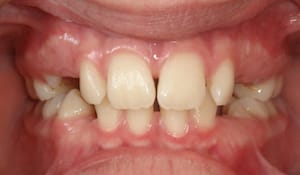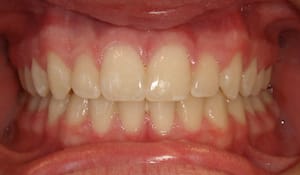Home - All About Braces - How to Know If You Need Braces - Spacing of Teeth

Erick practices orthodontics in our Riverton Oral Health office.
Spacing of Teeth: Large Gaps Between Teeth
Why Gaps Develop Between Teeth, What They Mean, and When Braces Might Help.


Spacing refers to noticeable gaps between the teeth — often most visible between the top front teeth. While some spacing can be purely cosmetic, larger or uneven gaps may indicate missing teeth, jaw size imbalances, or developmental issues that could affect long-term oral health.
Fortunately, spacing is one of the most treatable orthodontic concerns, often with simple and effective solutions.
What Causes Gaps Between Teeth?
- Genetics — inherited jaw and tooth size imbalance
- Missing or undersized teeth (such as lateral incisors)
- Tongue thrusting habits
- Prolonged thumb sucking or pacifier use
- Extra tissue (labial frenum) between the front teeth
- Teeth shifting due to periodontal issues in older patients
Signs of Problematic Tooth Spacing
- A visible space between the top front teeth
- Uneven spacing between multiple teeth
- Food regularly getting stuck between teeth
- Speech issues (especially whistling sounds)
- Difficulty biting or chewing
Why Treatment May Be Recommended
- Shifting or tilting of adjacent teeth
- Improper bite alignment
- Speech difficulties
- Risk of gum problems due to lack of tooth contact
- Esthetic concerns that impact confidence
How Is Spacing Treated?
Treatment will depend on the cause and severity of the spacing. Options may include:
- Braces to gradually move teeth closer together
- Clear aligners like Invisalign® for eligible teens or adults
- Frenectomy (removal of excess gum tissue) if a tight frenum is involved
- Tooth bonding or veneers (in cosmetic cases with small lateral teeth)
- Space maintainers or bridges if teeth are missing
Your orthodontist will recommend the best option based on your child’s needs, growth stage, and smile goals.
When to Schedule a Consultation
If your child has large gaps between their teeth — or if permanent teeth seem delayed or missing — it’s a good time to schedule an orthodontic consultation. At Families First, we offer complimentary consultations with imaging and personalized treatment recommendations.
We’ll help you understand what’s causing the spacing and whether early treatment can help guide your child’s long-term smile development.
Claim Your Complimentary Consultation
Our orthodontic team is here to help with complimentary orthodontic consultations in Bluffdale, Riverton, Stansbury Park, and West Jordan.
Complete the form below or call (801) 254-9700 to schedule.
Frequently Asked Questions
Is it normal for kids to have gaps in their teeth?
What causes a gap between the front teeth?
Can braces close gaps in teeth?
Can Invisalign fix gaps in teeth?
Is spacing just a cosmetic issue?
Not always. In some cases, spacing can lead to bite issues or gum health problems if not addressed.